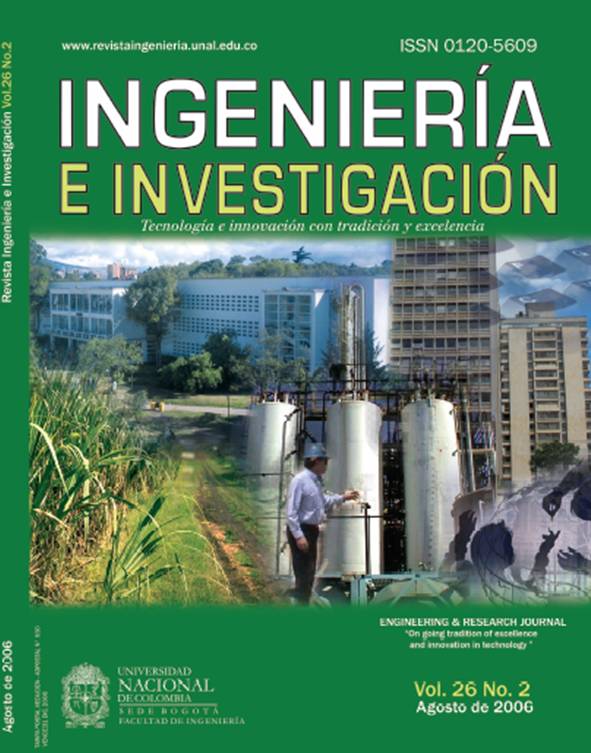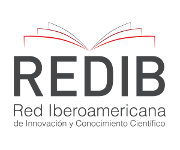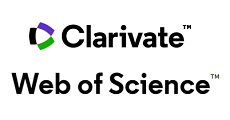Obtaining decorative chromium plating from trivalent chromium solutions
Obtención de un recubrimiento de cromo decorativo a partir de soluciones de cromo trivalente
DOI:
https://doi.org/10.15446/ing.investig.v26n2.14739Keywords:
plating, trivalent chromium, complexing, galvanising (en)recubrimiento, cromo trivalente, complejos, procesos galvánicos (es)
Downloads
The present work was aimed at a qualitative evaluation, in the laboratory, of different alternatives for assembling and operating a trivalent chromium bath for decorative chromium plating. Different chromium concentration solutions and different complexing agents were used. The initial result of this analysis was that chloride, formate and acetate solutions produced the best results. Solution preparation conditions were evaluated: temperature, chromium III complex formation time and also operation during the plating process: pH and temperature. The experimental work was done in the Alfacrom Ltda company; the parameters evaluated consisted of the appearance of chromium deposit and the minimum current density at which it appeared. Resistance to corrosion was tested in a saline-spray chamber, taking conventional hexavalent chromium plating as reference. This assay was done in the Universidad Nacional de Colombia’s Chemical Engineering Laboratory. It was concluded that trivalent chromium plating may represent a technical and economic alternative to conventional hexavalent chromium plating, this being a highly toxic and contaminant process. However, research should be continued into finding optimal process conditions.
El presente trabajo tiene como objetivo evaluar de forma cualitativa, a escala de laboratorio, diferentes alternativas para el montaje y operación de un baño de cromo trivalente para obtener recubrimientos de cromo decorativo. Fueron empleadas soluciones de diferentes concentraciones de cromo y diversos agentes formadores de complejos.
Este análisis arrojó como resultado inicial que de las soluciones compuestas de cloruros, formiatos y acetatos se obtienen los mejores resultados. Se evaluaron las condiciones de preparación de la soluciones: temperatura y tiempo de formación del complejo de cromo III; también la operación durante proceso de recubrimiento: pH y temperatura. El trabajo experimental fue desarrollado en la empresa Alfacrom Ltda., los parámetros de evaluación fueron: apariencia del depósito de cromo y densidad mínima de corriente a la que aparece el mismo. Se evaluó la resistencia a la corrosión en cámara salina, tomando como referencia un recubrimiento de cromo hexavalente convencional; este ensayo se realizó en el laboratorio de Ingeniería Química de la Universidad Nacional de Colombia. Se concluyó que el recubrimiento con soluciones de cromo trivalente puede ser una alternativa viable técnica y económicamente para cambiar los procesos de cromado convencionales que son altamente tóxicos y contaminantes; sin embargo, se debe continuar la investigación para encontrar las condiciones óptimas del proceso.
References
ACERCAR Industria, Planes de acción para mejoramiento ambiental GALVANOTECNIA., 2003.
Atotech USA Inc., Tri-chrome PLUS, Trivalent chromium plating process., Technical data sheet., 2004.
Barclay, D. J. y Morgan, W., Electrodeposition of Chromium., United States Patent 4 062 737, Diciembre, 1977.
Barclay, D. J., Vigar J. M.L.., Low concentration trivalent chromium electroplating solution and process., United States Patent 4 278 512., Julio 1981.
Benahen, P, y Tardy, R., Chromium electroplating trivalent chromium bath therefore and method of making such bath., United States Patent 4 612 091, Septiembre 1986.
Bernard, J. J. y Barnes C., Trivalent chromium plating bath., Patent Specification 1 488 381, Londres, 12 Octubre, 1977.
Dahlhaus, M., Calculating Corrosion., Products finishing, ENTHONE Germany, 2005.
Denis, A. J., Principles and Prevention of Corrosion., Mc Millan Publishing company, 1992.
Dubpernell, G., Chromium modern electroplating., Jhon Wiley & Son Inc, 1974.
ENTHONE Inc., Triclolyte IV, Trivalent Chromium Process., Technical data sheet, 2003.
Mc Dermid Inc., Trimac Envirochrome III, Decorative trivalent chromium., Technical data sheet, 2004.
Perry., Chemical Engineering’s Handbook., 7 ed, Mc Graw Hill,1999.
Pletcher, D., Industrial Electrochemistry., Chapman and Hall., 1991.
Shanin, G. E., Functional plating from solutions containing trivalent chromium ion., United States Patent 5 294 326., Marzo, 1994.
Snyder, D. y Jones, R., Decorative and Functional Trivalent Chromium electroplating., Atotech USA, Suffice Finished, 2004.
Song, Y. B., Chin, D.T., Current efficiency and polarization behavior of trivalent chromium electrodeposition process., Electrochemica Acta, Vol 48, 2002, pp 349-356. DOI: https://doi.org/10.1016/S0013-4686(02)00678-3
Szyncarzuk, J., Drella, I. y Kubicki J., Electrochemical behavior of chromium III in the presence of Formica Acid-I., Electrochimica Acta, Vol 34, No 3, 1989, pp 399-403. DOI: https://doi.org/10.1016/0013-4686(89)87017-3
Szyncarzuk, J., Drella, I., Kubicki J., Electroreduction of chromium (III)-acetate complex to metallic chromium on the copper electrode., Electrochimica Acta, Vol 33, No 4, 1988, pp 589-592. DOI: https://doi.org/10.1016/0013-4686(88)80184-1
Ward, J. y Barnes C., Trivalent chromium plating baths., United States Patent 4 157 945, Junio, 1979.
How to Cite
APA
ACM
ACS
ABNT
Chicago
Harvard
IEEE
MLA
Turabian
Vancouver
Download Citation
CrossRef Cited-by
1. Armando Espinoza-Gálvez, Carlos Frontana, René Antaño-López, Julieta Torres-González. (2021). Morphological insights associated to instantaneous nucleation and growth in Cr(III) electrodeposition on nickel in aqueous media. Journal of Materials Research and Technology, 15, p.7004. https://doi.org/10.1016/j.jmrt.2021.11.120.
Dimensions
PlumX
Article abstract page views
Downloads
License
Copyright (c) 2006 Óscar Javier Suárez García

This work is licensed under a Creative Commons Attribution 4.0 International License.
The authors or holders of the copyright for each article hereby confer exclusive, limited and free authorization on the Universidad Nacional de Colombia's journal Ingeniería e Investigación concerning the aforementioned article which, once it has been evaluated and approved, will be submitted for publication, in line with the following items:
1. The version which has been corrected according to the evaluators' suggestions will be remitted and it will be made clear whether the aforementioned article is an unedited document regarding which the rights to be authorized are held and total responsibility will be assumed by the authors for the content of the work being submitted to Ingeniería e Investigación, the Universidad Nacional de Colombia and third-parties;
2. The authorization conferred on the journal will come into force from the date on which it is included in the respective volume and issue of Ingeniería e Investigación in the Open Journal Systems and on the journal's main page (https://revistas.unal.edu.co/index.php/ingeinv), as well as in different databases and indices in which the publication is indexed;
3. The authors authorize the Universidad Nacional de Colombia's journal Ingeniería e Investigación to publish the document in whatever required format (printed, digital, electronic or whatsoever known or yet to be discovered form) and authorize Ingeniería e Investigación to include the work in any indices and/or search engines deemed necessary for promoting its diffusion;
4. The authors accept that such authorization is given free of charge and they, therefore, waive any right to receive remuneration from the publication, distribution, public communication and any use whatsoever referred to in the terms of this authorization.



























